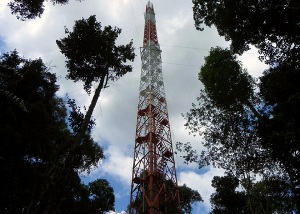Dec 12 2014
Construction of the steel structure, which will be taller than the Eiffel Tower, is due to be completed in early summer. Scientists from the MPI for Chemistry are playing a central role in its development and will also coordinate the research there.
 Steel giant in the rainforest: the Atto tower will deliver important climate data. © MPI for Chemistry
Steel giant in the rainforest: the Atto tower will deliver important climate data. © MPI for Chemistry
When Jürgen Kesselmeier wants to travel to the building site of the Amazonian Tall Tower Observatory (Atto), he faces a day and a half’s journey from the Brazilian metropolis of Manaus. He starts by car heading north, then turns east to the Balbina Dam, and continues further along the Uatumã River. Following a boat trip, the final leg of the journey is made by jeep along a jungle track. “Apart from the measurement station with two smaller 80-metre-tall towers, all there is here is forest,” says the project leader from the MPI for Chemistry in Mainz.
The new addition to the location, the Atto, is currently being built. Since the laying of the foundation stone, the tower has already reached a height of 270 metres. Construction will continue when the rainy season is over and the gigantic structure is due to be inaugurated in June 2015. Behind the work of the builders, technicians and scientists lies a logistical tour de force, which could only be achieved through their concerted efforts. For example, a Brazilian company transported the steel struts over land and river to the protected area and provided around 30 workers. They alternated in three-week shifts at the site, sleeping on hammocks in the camp close to the tower, which has its own kitchen, shower and WCs.
International teamwork
Technicians and scientists from the National Institute for Amazonia Research (INPA), the Universidade do Estado do Amazonas and the MPI for Chemistry will equip the gigantic structure with sensors, probes and pumps. Air will be sucked in from different levels and the proportion of aerosols it contains will be measured. The scientists also plan to study the processes involved in the transport of air masses which cover several hundred kilometres. “We want to understand where and why greenhouse gases like carbon dioxide, methane, nitrous oxide and other reactive trace gases form and accumulate,” explains Kesselmeier, whose team includes ten MPI staff members. He fondly recalls the first time he climbed to a height of 120 metres to take lunch to three colleagues. “I don’t have a great head for heights but there were plenty of places on the structure which provided a secure hold,” he explains. Moreover, his efforts were rewarded with a “magnificent view”. Nevertheless, Kesselmeier has a lot of respect for those who work at this height. He isn’t yet sure whether he will climb the 325 metres to the top of the tower. But he will definitely give it a try.
A unique location
It is not just the height that makes the Atto so special. In Dubai, climate measurement stations already exist at 800 metres on the roofs of skyscrapers. What is unique about Atto is the valuable ecosystem, in which the scientists are carrying out their measurements: It is the largest continuous forest area on Earth but is constantly shrinking due to interventions such as slash and burn and soya plantations. The Amazon rainforest has a huge influence on the weather as a CO₂ sink and freshwater reservoir and is enormously rich in species diversity.
The cost of constructing the measurement tower is around 8.4 million euros, around half of which is being funded by the German Federal Ministry of Education and Research and the Brazilian partners. The costs and effort are worthwhile, however, as Kesselmeier firmly believes that the Atto will help to answer questions about climate change and complement traditional climate models. Around 390 billion trees still stand in the world’s biggest tropical forest. Atto will soar above them all.